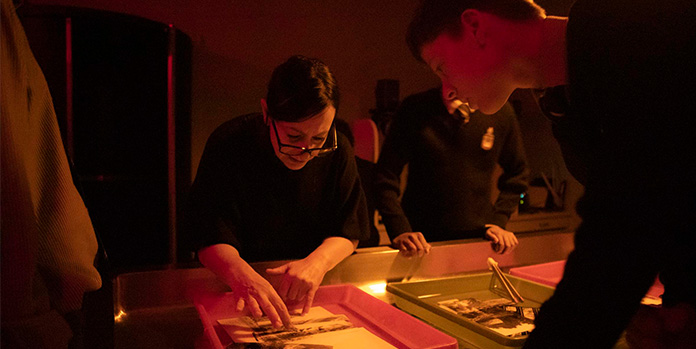Senior School Visual Arts teacher Cat Poljski explains the unexpected ways the study of photography can transform students’ understanding.
Why do we still teach traditional photographic techniques in the digital age? The answer is about much more than learning how photos used to be made. In fact, photography has the power to change the way students think, and to change the way they see themselves.
I’ve been lucky enough to teach the Photography elective available to Year 9 and 10 students for 22 years. It never gets dull. Today, students come into my classroom not knowing what a film camera is, and leave understanding the science behind creating a photo as well as the way choice, experimentation and collaboration define the final product.
We begin by investigating every part of the camera. Students quickly come to understand that they have only 24 frames in their roll of film, and that any exposure to light could risk their entire project. This is a completely different approach to the seemingly infinite capacity of their smartphones, but it’s this limitation that can inspire some of the best creative decisions.
Once the brief is set for a shoot, we head to our location and students are faced with a whole range of challenges. What will they shoot? Which angle will they choose? How will they work with the light that’s available? Watching students work on a shoot is incredible. I never fail to be impressed with their creative courage.
Back in the darkroom, a combination of science, memory and teamwork come into play. The whole process of film development has to happen in total darkness, which tests not only physical coordination but also teaches students to trust their instincts, rely on memory, and to work as a team. The darkroom can become its own world, and I’ve noticed students who rarely speak up in class becoming confident and communicative when they’re working to bring their photographs to life.
Of course, not every photo comes out of the darkroom a perfect masterpiece. Reflecting on our photographic failures together affirms that making a mistake isn’t a bad thing. In the darkroom, the next question after a photo fails is simply: How do I fix this next time?
Working with Year 9 and 10 students in classes together, I’ve also observed how transformative the study of photography can be on self-esteem. Older and younger students give each other feedback on an even playing field. It reminds me that even though the darkroom is a tiny space, it can also be a place where we find a new sense of who we are.
A photograph is not just the result of an encounter between an event and a photographer; picture-taking is an event in itself, and one with ever more peremptory rights-to interfere with, to invade, or to ignore whatever is going on.
Our very sense of situation is now articulated by the camera’s interventions.
The omnipresence of cameras persuasively suggests that time consists of interesting events, events worth photographing.
This, in turn, makes it easy to feel that any event, once underway, and whatever its moral character, should be allowed to complete itself so that something else can be brought into the world, the photograph.
After the event has ended, the picture will still exist, conferring on the event a kind of immortality (and importance) it would never otherwise have enjoyed.
Sontag, Susan (1933-2004). On Photography. New York: Farrar, Straus and Giroux, 1977.
You can view samples of Term I, 2022 Senior School photography work here.



